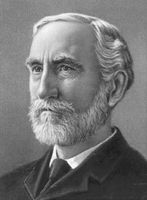I
(Gibbs)
Джеймс (23.12.1682, Футдисмир, близ Абердина, - 5.8.1754, Лондон), английский архитектор. Учился в Голландии и Италии (в 1700-09 у К. Фонтаны (См.
Фонтана)), сотрудничал с К.
Реном. Представитель классицизма. Постройки Г. отличаются внушительной простотой и цельностью композиции, изяществом деталей (церкви Сент-Мэри-ле-Стрэнд, 1714-1717, и Сент-Мартин-ин-зе-Филдс, 1722-1726, в Лондоне; библиотека Рэдклиффа в Оксфорде, 1737-49).
Лит.: Summerson J., Architecture in Britain. 1530-1830, Harmondsworth, 1958.
Дж. Гиббс. Библиотека Рэдклиффа в Оксфорде. 1737-49.
II
(Gibbs)
Джозайя Уиллард (11.2.1839, Нью-Хейвен, - 28.4.1903, там же), американский физик-теоретик, один из основоположников термодинамики и статистической механики. Окончил Йельский университет (1858). В 1863 получил степень доктора философии в Йельском университете, с 1871 профессор там же. Г. систематизировал термодинамику и статистическую механику, завершив их теоретическое построение. Уже в первых своих статьях Г. развивает графические методы исследования термодинамических систем, вводит трёхмерные диаграммы и получает соотношения между объёмом, энергией и энтропией вещества. В 1874-78 в трактате "О равновесии гетерогенных веществ" разработал теорию потенциалов термодинамических (См.
Потенциалы термодинамические), доказал правило фаз (общее условие равновесия гетерогенных систем), создал термодинамику поверхностных явлений и электрохимических процессов; Г. обобщил принцип энтропии, применяя второе начало термодинамики к широкому кругу процессов, и вывел фундаментальные уравнения, позволяющие определять направление реакций и условия равновесия для смесей любой сложности. Теория гетерогенного равновесия - один из наиболее абстрактных теоретических вкладов Г. в науку - нашла широкое практическое применение.
В 1902 были опубликованы "Основные принципы статистической механики, излагаемые со специальным применением к рациональному обоснованию термодинамики", явившиеся завершением классической статистической физики, первоосновы которой были заложены в работах Дж. К. Максвелла и Л. Больцмана. Статистический метод исследования, разработанный Г., позволяет получить термодинамические функции, характеризующие состояние вещества. Г. дал общую теорию флуктуаций величин этих функций от равновесных значений, определяемых формальной термодинамикой, и адэкватное описание необратимости физических явлений. Г. является также одним из создателей векторного исчисления в его современной форме ("Элементы векторного анализа", 1881- 1884).
В трудах Г. проявились замечательно точная логика, тщательность в отделке результатов. В работах Г. до сих пор не обнаружено ни одной ошибки, все его идеи сохранились в современной науке.
Соч.: The collected works, v. 1-2, N. Y. - L., 1928; The scientific papers, v. 1-2, N. Y., 1906; в рус. пер. - Основные принципы статистической механики, М. - Л., 1946; Термодинамические работы, М., 1950.
Лит.: Семенченко В. К., Д. В. Гиббс и его основные работы по термодинамике и статистической механике (К 50-летию со дня смерти), "Успехи химии", 1953, т. 22, в. 10; Франкфурт У. И., Френк А. М., Джозайя Виллард Гиббс, М., 1964.
О. В. Кузнецова.
Дж. У. Гиббс.



![The reaction C<sub>(s)</sub><sup>diamond</sup> → C<sub>(s)</sub><sup>graphite</sup> has a negative change in Gibbs free energy and is therefore thermodynamically favorable at 25 °C and 1 atm. However, the reaction is too slow to be observed, because of its very high [[activation energy]]. Whether a reaction is thermodynamically favorable does not determine its rate. The reaction C<sub>(s)</sub><sup>diamond</sup> → C<sub>(s)</sub><sup>graphite</sup> has a negative change in Gibbs free energy and is therefore thermodynamically favorable at 25 °C and 1 atm. However, the reaction is too slow to be observed, because of its very high [[activation energy]]. Whether a reaction is thermodynamically favorable does not determine its rate.](https://commons.wikimedia.org/wiki/Special:FilePath/Diamond.jpg?width=200)

![thermodynamic surface]]''' diagram for a fictitious water-like substance, transposed the two figures of Gibbs (above right) onto the volume-entropy coordinates (transposed to bottom of cube) and energy-entropy coordinates (flipped upside down and transposed to back of cube), respectively, of a three-dimensional [[Cartesian coordinates]]; the region AB being the first-ever three-dimensional representation of Gibbs free energy, or what Gibbs called "available energy"; the region AC being its capacity for [[entropy]], what Gibbs defined as "the amount by which the entropy of the body can be increased without changing the energy of the body or increasing its volume. thermodynamic surface]]''' diagram for a fictitious water-like substance, transposed the two figures of Gibbs (above right) onto the volume-entropy coordinates (transposed to bottom of cube) and energy-entropy coordinates (flipped upside down and transposed to back of cube), respectively, of a three-dimensional [[Cartesian coordinates]]; the region AB being the first-ever three-dimensional representation of Gibbs free energy, or what Gibbs called "available energy"; the region AC being its capacity for [[entropy]], what Gibbs defined as "the amount by which the entropy of the body can be increased without changing the energy of the body or increasing its volume.](https://commons.wikimedia.org/wiki/Special:FilePath/Gibbs-Maxwell surfaces.png?width=200)
